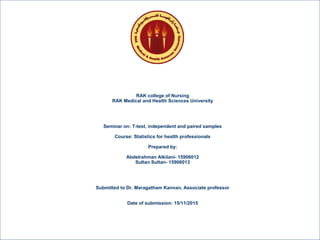
T test
- 1. RAK college of Nursing RAK Medical and Health Sciences University Seminar on: T-test, independent and paired samples Course: Statistics for health professionals Prepared by: Abdelrahman Alkilani- 15906012 Sultan Sultan- 15906013 Submitted to Dr. Maragatham Kannan, Associate professor Date of submission: 15/11/2015
- 2. Objectives By the end of this seminar, you’ll be able to: Define T-test Discuss the merits and demerits of t-test Identify the independent t-test and discuss when to use it. Identify the paired t-test and discuss when to use it. Use the correct formulas of t-test Use the t-test through SPSS
- 3. T-test The t-test assesses whether the means of two groups are statistically different from each other
- 4. Merits and demerits Merits: – It reduces the possibility of guising the correct answer . – It covers greater amount of contents than matching types test. Demerits – it is only appropriate for questions that can be answered by short responses – There is a difficult in scoring when the questions are not prepared properly and clearly
- 5. Independent t-test It is a parametric test used to determine if a difference exists in the means of two groups on a particular characteristic.
- 6. Independent t-test Used when: – The grouping variables is dichotomous – The variable measuring the characteristics of interest is normally distributed. – The variable measuring the characteristic of interest in interval or ratio – The measure of each value of the variable, which measures the characteristic of interest, constitute and independent random sample
- 7. Computing the independent t-test Need two t-values: – Calculated t-value – Critical t-value If calculated t-value is greater than critical t- value, then reject the null hypothesis.
- 8. Computing the independent t-test Example: In a study, we want to know whether smokers and non-smokers have equal brain sizes.
- 9. n Non-smokers Smokers 1 7.3 4.2 2 6.5 4.0 3 5.2 2.6 4 6.3 4.9 5 7.0 4.4 6 5.9 4.4 7 5.2 5.5 8 5.0 5.1 9 4.7 5.1 10 5.7 3.2 11 5.7 3.9 12 3.3 3.2 13 5.0 4.9 14 4.6 4.3 15 4.8 4.8 16 3.8 2.4 17 4.6 5.5 18 5.5 19 3.7
- 10. Computing the independent t-test 1. State the null and alternative hypothesis. H0 : There will be no difference in the means of the two groups. “smokers and non-smokers have equal brain size” HA : smokers and non-smokers have unequal brain size
- 11. Computing the independent t-test
- 12. Computing the independent t-test
- 14. Computing the independent t-test As the calculated t-value (3.07) greater than critical t-value (2.042), the null hypothesis can be rejected.
- 15. Independent t-test using SPSS
- 16. Independent t-test using SPSS 1- check if it is normally distributed
- 17. A- Put the independent variables in the factor list B- Put the dependent variable in the dependent list C- Click on “Plots” and choose “histogram”
- 18. A- in the output window, double click on the histograms of the independent variables. The choose the icon of curve
- 19. A- in the output window, double click on the histograms of the independent variables. The choose the icon of curve
- 20. 2- Compare the means of the independent variable
- 21. A- Put the independent variables as the grouping variables B- Define the groups as entered in the SPSS. E.g. Gender; Male=M, Female=F
- 22. -Sig = 0.679 -alpha= 0.05 -Sig > alpha. So, we will reject the null hypothesis
- 23. Paired t-test The measurements of the same variable at two different points are compared. It can be measured at the same time on two different people who are matched on some condition (e.g. age, gender, twins).
- 24. Paired t-test Used when: – There are two measurements of characteristic of interest. – The two measures that are compared are normally distributed or at least 30 pairs. – The measurement scale is either interval or ratio.
- 25. Computing the paired t-test Need two t-values: – Calculated t-value – Critical t-value If calculated t-value is greater than critical t- value, then reject the null hypothesis.
- 26. Computing the paired t-test Pre post Difference (D) Difference 2 1 7 6 36 2 6 4 16 1 8 7 49 Sum=17 Sum = 101
- 27. Computing the paired t-test
- 28. Computing the paired t-test
- 29. Computing the paired t-test Degree of freedom = n-1 = 2 Alpha = 0.05 Critical t from the t- table = 2.92
- 30. Computing the paired t-test Calculated t > critical t 6.425 > 2.92 We will reject the null hypothesis. So, there is a difference between pre and post
- 31. Paired test using SPSS
- 32. 1- check the normal distribution the same as we did in the independent variables
- 33. 1- check the paired sample t-test
- 34. Paired test using SPSS As the sig. < alpha 0.023 <0.05 Null hypothesis will be accepted
- 35. Summary The t-test assesses whether the means of two groups are statistically different from each other Independent t- test is to determine if a difference exists in the means of two groups on a particular characteristic. Paired samples t-test is a measurements of the same variable at two different points are compared
- 36. Summary To calculate t-test, we need two t-values: – Calculated t-value – Critical t-value If calculated t-value is greater than critical t- value, then reject the null hypothesis. In SPSS: – analyze for normal distribution – Perform the test – If the sig < alpha value, null hypothesis will be accepted
- 37. Reference Stacey B., Laurel S. (1st edtion). Statistics for Nursing and Allied Health
